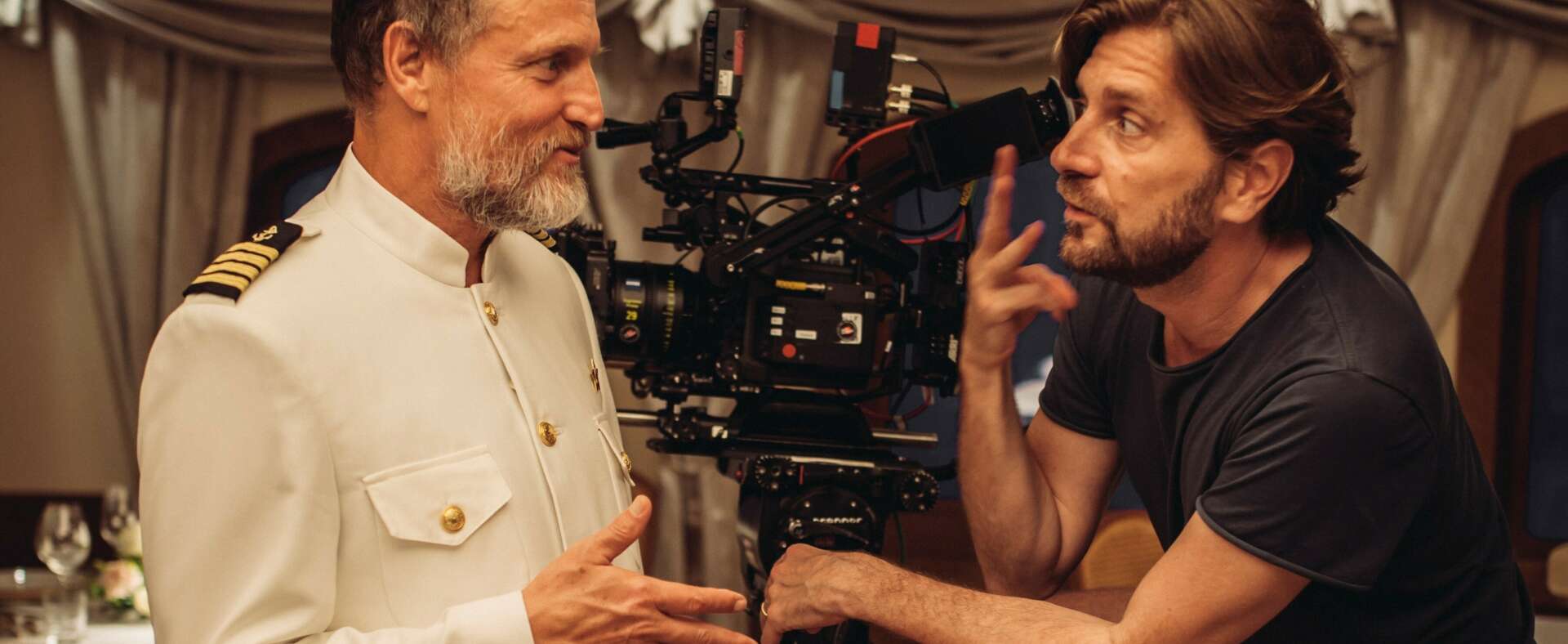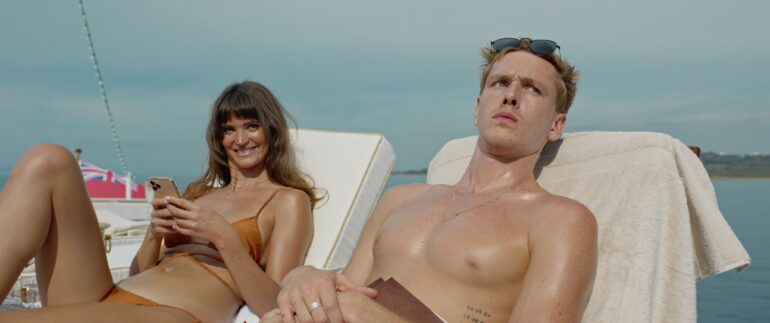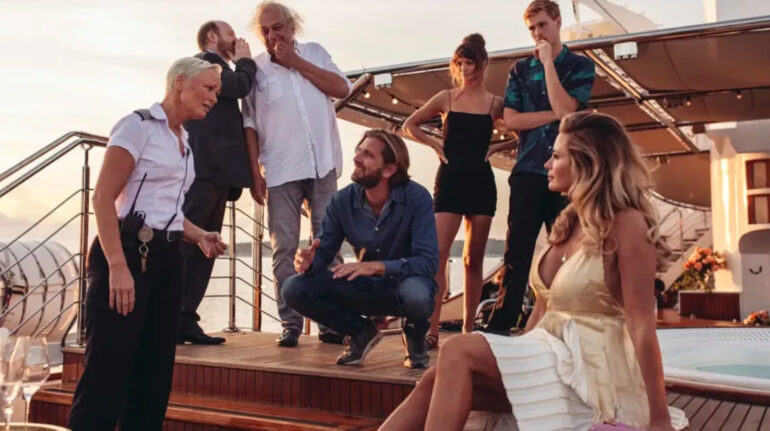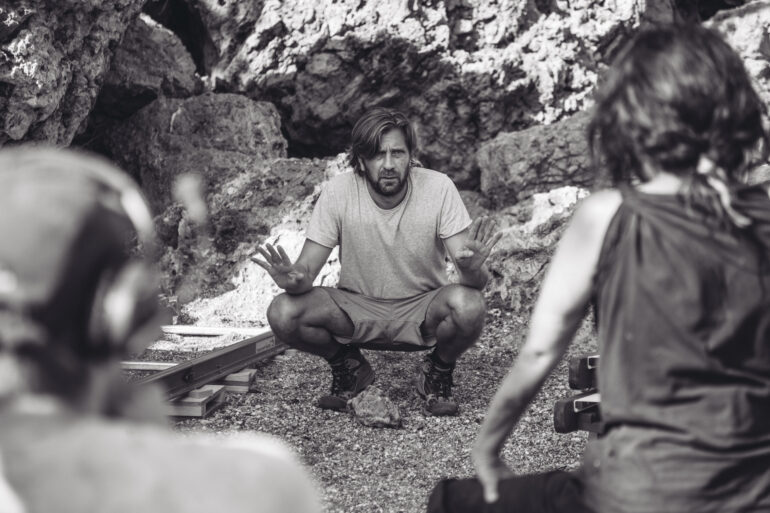
The Swedish director and former Palme d’or winner tells us about his vision of film as “an entertaining though-provoking rollercoaster for adults.”
Five years after winning the coveted Palme d’or in Cannes with The Square, Östlund is back in the main competition with his first foray into English-language and most ambitious film to date: Triangle of Sadness, set to world premiere May 21 in Cannes. The director’s long-time production partner Erik Hemmendorff is producing, alongside Philippe Bober.
The story penned by Östlund follows the young models Carl (Harris Dickinson) and Yaya, (Charlbi Dean) invited on a luxury cruise with a group of super-rich and a Marxist captain (Woody Harrelson). After a stormy evening which provokes heavy sea sickness from the billionaires who had enjoyed a seven-course dinner, everyone - including the ship’s cleaners - ends up stranded on a desert island. Social hierarchy is suddenly flipped upside down, as the Filipino housekeeper is the only one who knows how to fish.
The title ‘Triangle of Sadness’ refers to a term used in plastic surgery, referring to the frown lines between the eyes, that models often try to eliminate with plastic surgery.
We spoke to Östlund on the eve of the Cannes Film Festival.
Before going into the topic of the film, could you explain your magic mix which is to combine entertainment with thought-provoking subject-matters, a formula which you applied successfully with The Square?
Ruben Östlund: With Force Majeure, The Square, and now with this 3rd film, I try to define the set-up where I think people would like to spend time - be it a ski resort, the art world or here, a deserted island, luxury boat and the fashion world. Then I create a story that I hope will draw people in, and at the same time offer thought-provoking and interesting questions, using cinema as an art form. When you look at European cinema in the 60s or 70s films from Luis Buñuel or Lina Wertmüller, they were doing exactly this: entertaining films that were also asking questions.
But my goal is not to be reduced to arthouse, which is a genre in itself. I love to get rid of my baggage from film school that was so affected by the idea that if you want to do something important it has to be this particular way.
I wanted to be inspired by the Americans, in the way they approach cinema. Some of the best filmmakers in the world, when it comes to the film craft, definitely come for the US and some of the most interesting filmmakers in the world definitely come from Europe-from Michael Haneke, Roy Andersson, to Catherine Breillat. They are bold and daring, while at the same time respecting the craft of American films. So I wanted to made an entertaining though-provoking rollercoaster for adults. That is what I want to see on the big screen - as well as being taken on a ride.
You push the cinematic experience while staying truthful to the recurrent theme in your films, which is group behaviour. Here, how are you exploring this?
RÖ: I guess the best illustration of group behaviour for me was in my film Involuntary which had five different situations seen from five different group perspectives. Group behaviour study [in my films] is perhaps inevitable, as human beings are herd animals.
I use a psychological and behavioural approach to characters, and don’t like to talk about specific individuals doing something because of their specific background. I look at us as human beings, and the way we behave in a certain way, because of the materialistic society in which we evolve. Here it’s about hierarchy in society, how our behaviour stems from the position we have in that hierarchy. I look at people from the perspective of social and economic structures.
And I believe a lot of people behave in different ways when placed in different positions of the social hierarchy. For instance, with me, the few times I’ve flown in business class, I’ve had the feeling that things move a bit slower-you look at the other passengers, how they sink into their comfy seats, and it happens without even me thinking about it.
You’ve mentioned when preparing the film a few years ago, that you got the idea to set the story in the fashion world, after a discussion with your wife who is a fashion photographer. Can you tell us about the specific aspects of that industry that you are exploring in the film?
RÖ: I started researching the topic in the middle of the #MeToo movement. You could hear so many examples of women who had been used by powerful men in the industry, viewed as possible door openers for their career. In our society, beauty can be a way to move up the social ladder. My wife also told me about male models who actually earn one third of what women make, and many of them have to deal with sexual harassment from gay heavy-hitters in the industry. It was an interesting starting point to look at beauty and sexuality as a currency. We are all aware that these are currencies - even in normal relationships. I’m sorry to say but you can’t separate love from money!
So in the film, the two models are invited to a luxury yacht, there they meet the super-rich, a Russian oligarch, British arm dealers, a Marxist captain. I use the film to talk about how our behaviour is very dependent on materialism and our position in a hierarchy. At the end it’s a satire and fun dark comedy to make us reflect about this.
Fashion is indeed a perfect environment to dissect behaviourism…
RÖ: The fashion world is aware of our behaviour; they know why we consume what we consume. For instance, there was a study that drew the parallel between the fashion industry and zebras in the savanna. A scientist asked himself why do they have a black and white fur, a camouflage, when in the sandy savanna? Shouldn’t it be a yellow colour? But then, individual zebras do disappear once in the herd. He sprayed a red dot on one zebra, that could be followed, but it was also spotted, hunted and killed by lions.
So the article established an interesting parallel with the fashion world. It works in the same way, and we work in the same way: when we dress, we do this to fit in the group. We don’t want to be over-dressed and don’t want to be under-dressed either. Look at the red carpet in Cannes, it is absurd when you think how people are obsessed about what to wear!
The fashion industry has learnt about how to capitalise on people’s behaviour.
In the film you also make interesting comments about brands, how they use different techniques to attract different consumers…
RÖ: Yes marketing strategies for different brands was something I wanted to discuss as well. If you have cheaper brands, then the models smile on the advertising. Their message is ‘welcome to our community!' Everyone is invited to join. But with more expensive brands, the smiles disappear on the faces of the models. They almost look down at consumers. It’s like ok, you can buy your position up here, it will cost you a lot of money but you will be on top of the hierarchy. It’s fun to look at those strategies.
Could you discuss the casting? I understand that this process took between 6-8 months…
RÖ. I get so much back from doing the casting. I try scenes, do improvisations and when I see the actors during casting, I sometimes think wow-I want to add this to the script. So we went to many world cities, Manilla, L.A., NY, Paris, London among others.
Woody Harrelson is fantastic as the Marxist captain, and he had a great sidekick in Zlatko Buric who plays a Russian oligarch. The two play the great Eastern and Western block clashing with different political ideologies. Then you have the two young models Carl and Yaya played by Harris Dickinson from the UK and Charlbi Dean from South Africa.
I loved their improvisations. They do this fantastic scene around paying a bill, where she expects him to pick up the bill. Again, it’s about questioning conventions. That’s a very funny scene. My wife and I were in a similar situation. We had a huge fight.
How was it to work with Woody Harrelson?
RÖ: It was fun. I was nervous as you never know how it will be to work with an elder alpha male person who has been in the industry, as a star for such a long time. It was important for me to talk to him, to be honest. The first days, we were observing each other, a bit like in a boxing ring. He also comes from the US system where the big star actors are bigger than some directors. Here, I wanted him to come down to my level.
He did amazing things. His character enjoys having dinners when there is a storm. It’s the Marxist captain’s revenge on the luxury yacht’s hosts. He is also alcoholic. But it’s not easy to play drunk. It’s about how you deliver the dialogue, with a small delay in the delivery. It was super interesting to see him doing those things.
Could you tell us about the challenge of creating the climax scene when the yacht is caught in the storm? When preparing the film, you said it would be ‘the wildest scene in history’…
RÖ: Josefin Åsberg our production design and her team did an amazing job. We had to build the set on a studio on a gimball [pivotal support] to make it rock. We built three floors, including the dining room, stairs, hallway, one of the cabins. There were like 80 people in the dining room so it was a big construction. It was a hell of a challenge. The other challenge was in the editing. I wanted to create chaos but control it. I didn’t want it to happen randomly but in a precise way. So I directed it in a certain way and then in the editing, we worked on it for four months or so. The whole editing phase was very long.
What do you hope the viewers will take away from watching your film, especially in Cannes in the extraordinary conditions of the Grand Théâtre Lumière?
RÖ: Since I always try to confront myself, the class I’m coming from, the way I am in the social hierarchy, Triangle is the perfect film to present in Cannes.
One thing that I’d like is for people to go to the cinema, watch the film, go to a dinner afterwards and start to discuss the film. If you manage to get the people not to forget your film, then it’s magic. I love it.
What’s next?
RÖ: Every time we have a premiere in Cannes, there is a little table in a little cafe a few hundred meters from the Croisette where I sit down with Erik [Hemmendorff, producer] and Kalle Boman [legendary Swedish producer and mentor to Östlund] and talk about the next project. What we’ve discussed is the idea of a film taking place in a long haul flight.
After take-off, the crew suddenly announces that unfortunately, the entertainment system is down so you are now doomed to sit for 16 hours without any digital entertainment…no films!
It will be like an experimental lab looking at our behaviour, this time in the air!


